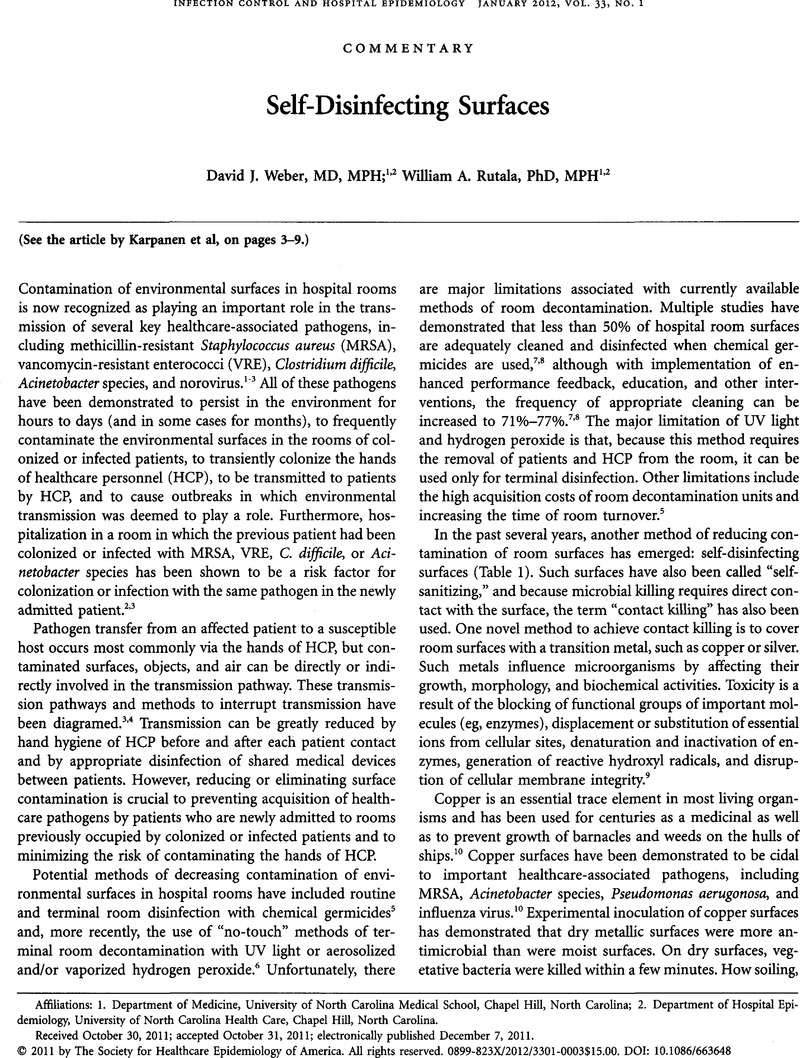Crossref Citations
This article has been cited by the following publications. This list is generated based on data provided by Crossref.
Worthington, Tony
Karpanen, Tarja
Casey, Anna
Lambert, Peter
and
Elliott, Tom
2012.
Reply to Weber and Rutala.
Infection Control & Hospital Epidemiology,
Vol. 33,
Issue. 6,
p.
645.
Abreu, A. C.
Tavares, R. R.
Borges, A.
Mergulhao, F.
and
Simoes, M.
2013.
Current and emergent strategies for disinfection of hospital environments.
Journal of Antimicrobial Chemotherapy,
Vol. 68,
Issue. 12,
p.
2718.
Schmidt, Michael G.
Attaway, Hubert H.
Fairey, Sarah E.
Steed, Lisa L.
Michels, Harold T.
and
Salgado, Cassandra D.
2013.
Copper Continuously Limits the Concentration of Bacteria Resident on Bed Rails within the Intensive Care Unit.
Infection Control & Hospital Epidemiology,
Vol. 34,
Issue. 5,
p.
530.
Weber, David J.
Anderson, Deverick J.
Sexton, Daniel J.
and
Rutala, William A.
2013.
Role of the environment in the transmission of Clostridium difficile in health care facilities.
American Journal of Infection Control,
Vol. 41,
Issue. 5,
p.
S105.
Salgado, Cassandra D.
Sepkowitz, Kent A.
John, Joseph F.
Cantey, J. Robert
Attaway, Hubert H.
Freeman, Katherine D.
Sharpe, Peter A.
Michels, Harold T.
and
Schmidt, Michael G.
2013.
Copper Surfaces Reduce the Rate of Healthcare-Acquired Infections in the Intensive Care Unit.
Infection Control & Hospital Epidemiology,
Vol. 34,
Issue. 5,
p.
479.
Weber, David J.
and
Rutala, William A.
2013.
Self-disinfecting surfaces: Review of current methodologies and future prospects.
American Journal of Infection Control,
Vol. 41,
Issue. 5,
p.
S31.
Park, Geun Woo
Cho, Min
Cates, Ezra L.
Lee, David
Oh, Byung-Taek
Vinjé, Jan
and
Kim, Jae-Hong
2014.
Fluorinated TiO2 as an ambient light-activated virucidal surface coating material for the control of human norovirus.
Journal of Photochemistry and Photobiology B: Biology,
Vol. 140,
Issue. ,
p.
315.
Dancer, Stephanie J.
2014.
Controlling Hospital-Acquired Infection: Focus on the Role of the Environment and New Technologies for Decontamination.
Clinical Microbiology Reviews,
Vol. 27,
Issue. 4,
p.
665.
Otter, Jonathan A.
2014.
Use of Biocidal Surfaces for Reduction of Healthcare Acquired Infections.
p.
137.
Walker, J.T.
2014.
Decontamination in Hospitals and Healthcare.
p.
92.
Otter, J.A.
Yezli, S.
Perl, T.M.
Barbut, F.
and
French, G.L.
2014.
Decontamination in Hospitals and Healthcare.
p.
413.
Schmidt, M.G.
John, J.F.
and
Johnson Va, Ralph H.
2014.
Decontamination in Hospitals and Healthcare.
p.
232.
Schmidt, Michael G.
Banks, Andrea L.
and
Salgado, Cassandra D.
2014.
Use of Biocidal Surfaces for Reduction of Healthcare Acquired Infections.
p.
59.
Schmidt, Michael
2015.
Practical Handbook of Microbiology, Third Edition.
p.
3.
Jamali, Amir
Razavizadeh, Serajoddin
Aliahmadi, Atousa
and
Ghomi, Hamid
2017.
Antibacterial activity of silver and zinc oxide nanoparticles produced by spark discharge in deionized water.
Contributions to Plasma Physics,
Vol. 57,
Issue. 8,
p.
316.
Brühwasser, C.
Heinrich, H.
Lass-Flörl, C.
and
Mayr, A.
2017.
Self-disinfecting surfaces and activity against Staphyloccocus aureus ATCC 6538 under real-life conditions.
Journal of Hospital Infection,
Vol. 97,
Issue. 2,
p.
196.
Valiei, Amin
Okshevsky, Mira
Lin, Nicholas
and
Tufenkji, Nathalie
2018.
Anodized Aluminum with Nanoholes Impregnated with Quaternary Ammonium Compounds Can Kill Pathogenic Bacteria within Seconds of Contact.
ACS Applied Materials & Interfaces,
Vol. 10,
Issue. 48,
p.
41207.
Chyderiotis, S.
Legeay, C.
Verjat-Trannoy, D.
Le Gallou, F.
Astagneau, P.
and
Lepelletier, D.
2018.
New insights on antimicrobial efficacy of copper surfaces in the healthcare environment: a systematic review.
Clinical Microbiology and Infection,
Vol. 24,
Issue. 11,
p.
1130.
Doll, Michelle
Stevens, Michael P.
and
Bearman, Gonzalo
2018.
Infection Prevention.
p.
55.
Weber, David J.
Rutala, William A.
Sickbert-Bennett, Emily E.
Kanamori, Hajime
and
Anderson, Deverick
2019.
Continuous room decontamination technologies.
American Journal of Infection Control,
Vol. 47,
Issue. ,
p.
A72.



